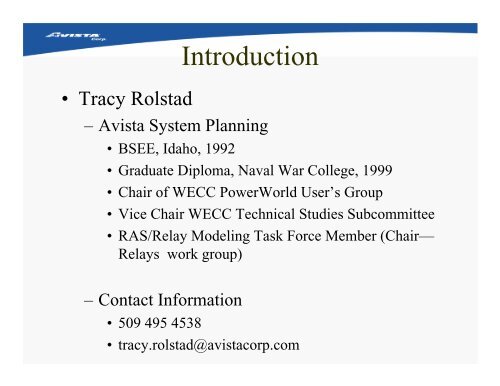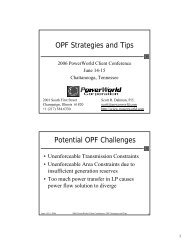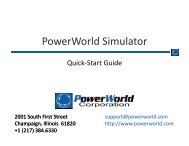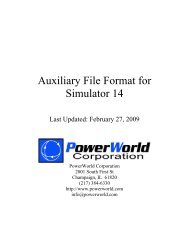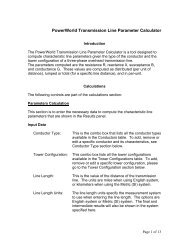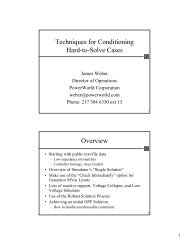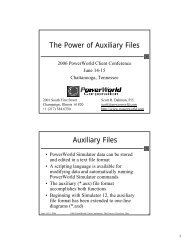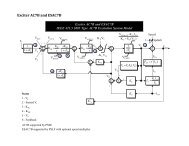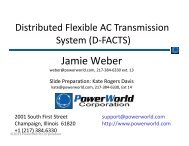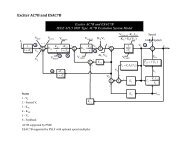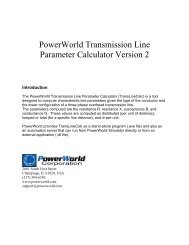Transient Stability Relay Models - PowerWorld
Transient Stability Relay Models - PowerWorld
Transient Stability Relay Models - PowerWorld
Create successful ePaper yourself
Turn your PDF publications into a flip-book with our unique Google optimized e-Paper software.
• Tracy Rolstad<br />
Introduction<br />
– Avista System Planning<br />
• BSEE, Idaho, 1992<br />
• Graduate Diploma, Naval War College, 1999<br />
• Chair of WECC <strong>PowerWorld</strong> User’s Group<br />
• Vice Chair WECC Technical Studies Subcommittee<br />
• RAS/<strong>Relay</strong> Modeling Task Force Member (Chair—<br />
<strong>Relay</strong>s work group)<br />
– Contact Information<br />
• 509 495 4538<br />
• tracy.rolstad@avistacorp.com
<strong>Relay</strong> “<strong>Models</strong>”…Why?
What Happened?
Our Regulator’s Words<br />
•The word <strong>Relay</strong> is mentioned 136 times<br />
– RAS mentioned 99 times<br />
•The word Model is mentioned 128 times
WECC Direction<br />
Not entirely correct,<br />
we model some relays.<br />
This might be worse than<br />
not modeling relays at all.<br />
We may not POPULATE<br />
models for all relays.<br />
However, we can (from a<br />
coding viewpoint) model<br />
any relay that exists. We<br />
need to recognize that if<br />
a relay can be built we<br />
CAN model it…we MAY<br />
choose NOT to.
The Path Forward…<br />
• We can simulate relay behavior NOW!<br />
– Simulate for the purposes of<br />
operations/planning studies<br />
• This is NOT the same as a protection system level<br />
model of a relay<br />
– Repeat the Above!<br />
• These relay “models” mostly REPLACE switch<br />
“decks” and other non-syntax based<br />
files/scripts/code<br />
– DO NOT CONFUSE THE ISSUE!!!! WE ARE NOT<br />
SETTING PROTECTION SYSTEM PARAMETERS<br />
• We want to do OUR job better, not yours<br />
– Our=System Modeler, Yours=Protection
Existing Technology<br />
• Present coding tools and methods can:<br />
– Simulate ANY relay, RAS, or other protective<br />
function that exists in the field today<br />
• Will Power versus Won’t Power<br />
– Digital is Digital, software code = hardware for simulation<br />
– However, we are here to talk about existing<br />
deployed software that requires NO<br />
development<br />
• Version 17 is very sophisticated in native toolset
<strong>PowerWorld</strong> Line <strong>Relay</strong> <strong>Models</strong><br />
• Timeline<br />
– Nothing existed prior to Summer 2012<br />
• Including these in stability is something that transient stability<br />
software users were not clamoring for until the WECC MSRATF<br />
started<br />
– August 2012<br />
• TLIN1 properly functioning and reporting events<br />
– October 2012<br />
• Added support for Impedance/Distance <strong>Relay</strong>s<br />
– December 2012<br />
• Added Time-Inverse Over-Current <strong>Relay</strong>s<br />
• Complexity of software for basic line relays is very low<br />
– Compare time for the complete implementation of a model<br />
including simulation code, user interface, and help<br />
documentation<br />
– Pacific DC Intertie Dynamic Model 20 days<br />
– Time-Inverse Over-Current <strong>Relay</strong> 1 day
<strong>PowerWorld</strong> Line <strong>Relay</strong> <strong>Models</strong><br />
• <strong>PowerWorld</strong> Simulator Version 17 includes<br />
the following models<br />
– Under Voltage and Frequency <strong>Relay</strong>s<br />
• TLIN1<br />
– Impedance/Distance <strong>Relay</strong>s<br />
• DISTR1, ZLIN1, ZQLIN1, ZPOTT, ZDCB<br />
– Out-of-Step Impedance <strong>Relay</strong>s<br />
• OOSLEN, OOSLNQ<br />
– Time Inverse Over-Current <strong>Relay</strong>s<br />
• LOCTI, TIOCR1
<strong>PowerWorld</strong> Line <strong>Relay</strong> <strong>Models</strong><br />
• Line <strong>Relay</strong> Data Structure Considerations<br />
– Model is assigned to specified end of a Branch.<br />
Handled by field in case information displays<br />
called Device Location which is From or To<br />
– Multiple relays can be assigned to each end of a<br />
branch<br />
• Distance <strong>Relay</strong>, Time-Inverse Over-Current, Voltage,<br />
etc…<br />
• For some types multiple relays of same type are allowed<br />
(introduced extra key field of Device ID)<br />
• User Interface Considerations<br />
– <strong>Stability</strong> tab is available on the branch dialog<br />
– Line relay models listed
User Interface
Visualization<br />
• Columns on Impedance <strong>Relay</strong>s show<br />
Forward Reach %<br />
• Ability to Show <strong>Relay</strong><br />
Zone Visualization
Deployed Software<br />
• <strong>PowerWorld</strong> Simulator ver 17<br />
– <strong>Models</strong> around 37 various “relays<br />
• Software testing is only truly valid as data is<br />
populated by users and then relay actions are<br />
analyzed<br />
• The tool is ready for use NOW<br />
• “Switch decks” are likely a thing of the past for 3<br />
phase bolted fault “criteria studies”<br />
– They should be a thing of the past
Present Software<br />
• Surprisingly sophisticated considering<br />
– <strong>Relay</strong>s models are seldom populated<br />
• These models have been around for<br />
DECADES<br />
• BS Bingo Alert: Paradigm Shift Ahead<br />
•AParadigm Shift is a change from one way of<br />
thinking to another. It's a revolution, a<br />
transformation, a sort of metamorphosis. It just does<br />
not happen, but rather it is driven by:<br />
• Agents of change
The “Old” Way
The “New” Automatic Way
Apply Fault—Run—Analyze
ZPOTT Dialog & Plot
“Typical” Distance <strong>Relay</strong>
Issues (for impedance relays)<br />
• This is “New” for Planners<br />
– <strong>Relay</strong> data sheets are large, ~40 pages<br />
• We need perhaps 5 numbers from these 40 pages<br />
• What to watch for…<br />
– Pesky instrument transformers<br />
• Ratios<br />
– Per unit v.s. ohms<br />
– Methods probably vary from utility<br />
• However,<br />
– General practices help…90% protection Zone 1
<strong>Relay</strong> Data Location
Output
Example
<strong>Relay</strong> Data vs Power Flow Data<br />
Devil's Gap - Ninemile is a 115 kV line. The impedance base for a 115 kV line is as follows:<br />
ZBase = Vbase^2/SBase = (115,000)^2/100,000,000 = 132.25<br />
In the WECC base cases, the following per unit impedance is seen<br />
Rpu+jXpu = 0.0186 + j0.10293 per unit<br />
Conversion to Ohms --> 2.4599 + j 13.612<br />
Amazing! Your power flow case matches the data the relay people are using exactly!<br />
Thus, inside simulator when you say you want "Z1P" or "Z1MP" to be 2.98 Ohms,<br />
you must convert this to per unit as<br />
2.98/132.25 = 0.022533 per unit<br />
Thus, inside Simulator the respective Rf1 parameter would be 0.0225<br />
This provides an excellent second check on power flow and relay data
X1=X, X2=R<br />
Check with Equation<br />
SQRT((X1^2)+(X2^2)^2)<br />
(ATAN(X1/X2))*57.2957795
Assessment<br />
• Will Power v.s. Won’t Power<br />
• WE CAN MODEL RELAYS TODAY!!!!<br />
– There is NO relay that can’t be modeled!<br />
• Code changes might be required if users assist<br />
developers<br />
– Software developers are way ahead of users<br />
• PTI: In 11 Manuals the word relay is mentioned 1017<br />
times!<br />
• Those who say it can’t be done…<br />
• Let us see your fingers on a keyboard!<br />
• Modeling of relays in the power flow<br />
simulations is another consideration<br />
– Will be discussed in separate presentation later
Final Word (5 minute job)
In GE *.dyd if You Like (10 min)<br />
zpott 48025 "BEACON N " 230.00 "1 " 40090 "BELL S3 " 230.00 "5" 1 : #9 0 0 0.05 0 83.905 0.007839 0 0 0<br />
0.004 0 83.905 0.010452 0 0 0 0.004 0 0 0 0 0 0 0.004<br />
zpott 48031 "BEACON S " 230.00 "1 " 40092 "BELL S4 " 230.00 "4" 1 : #9 0 0 0.05 0 83.978 0.00819 0 0 0<br />
0.004 0 83.978 0.01092 0 0 0 0.004 0 0 0 0 0 0 0.004<br />
zpott 40519 "HATWAI " 230.00 "1 " 48197 "LOLO " 230.00 "1" 1 : #9 0 0 0.05 0 83.929 0.010746 0 0 0<br />
0.004 0 83.929 0.014328 0 0 0 0.004 0 0 0 0 0 0 0.004<br />
zpott 40519 "HATWAI " 230.00 "1 " 48249 "MOSCOW " 230.00 "1" 1 : #9 0 0 0.05 0 83.76 0.023706 0 0 0<br />
0.004 0 83.76 0.031608 0 0 0 0.004 0 0 0 0 0 0 0.004<br />
zpott 40519 "HATWAI " 230.00 "1 " 48255 "N LEWIST " 230.00 "1" 1 : #9 0 0 0.05 0 84.759 0.008928 0 0 0<br />
0.004 0 84.759 0.011904 0 0 0 0.004 0 0 0 0 0 0 0.004<br />
zpott 40551 "HOT SPR " 230.00 "1 " 48281 "NOXON " 230.00 "2" 1 : #9 0 0 0.05 0 83.77 0.092169 0 0 0<br />
0.004 0 83.77 0.122892 0 0 0 0.004 0 0 0 0 0 0 0.004<br />
zpott 48443 "VANT AVA " 230.00 "1 " 46169 "WANAPUM " 230.00 "1" 1 : #9 0 0 0.05 0 83.766 0.101925 0 0<br />
0 0.004 0 83.766 0.1359 0 0 0 0.004 0 0 0 0 0 0 0.004<br />
zpott 48025 "BEACON N " 230.00 "1 " 48357 "RATHDRUM " 230.00 "2" 1 : #9 0 0 0.05 0 85.221 0.034128 0 0<br />
0 0.004 0 85.221 0.045504 0 0 0 0.004 0 0 0 0 0 0 0.004<br />
zpott 48031 "BEACON S " 230.00 "1 " 48524 "BOULDER " 230.00 "1" 1 : #9 0 0 0.05 0 85.134 0.015858 0 0 0<br />
0.004 0 85.134 0.021144 0 0 0 0.004 0 0 0 0 0 0 0.004<br />
zpott 48037 "BENEWAH " 230.00 "1 " 48249 "MOSCOW " 230.00 "1" 1 : #9 0 0 0.05 0 83.764 0.058149 0 0 0<br />
0.004 0 83.764 0.077532 0 0 0 0.004 0 0 0 0 0 0 0.004<br />
zpott 48037 "BENEWAH " 230.00 "1 " 48317 "PINE CRK " 230.00 "1" 1 : #9 0 0 0.05 0 82.068 0.057555 0 0 0<br />
0.004 0 82.068 0.07674 0 0 0 0.004 0 0 0 0 0 0 0.004<br />
zpott 48037 "BENEWAH " 230.00 "1 " 48385 "SHAWNEE " 230.00 "1" 1 : #9 0 0 0.05 0 84.952 0.076419 0 0<br />
0 0.004 0 84.952 0.101892 0 0 0 0.004 0 0 0 0 0 0 0.004<br />
zpott 48524 "BOULDER " 230.00 "1 " 48037 "BENEWAH " 230.00 "1" 1 : #9 0 0 0.05 0 83.802 0.034308 0 0 0<br />
0.004 0 83.802 0.045744 0 0 0 0.004 0 0 0 0 0 0 0.004
Questions?


